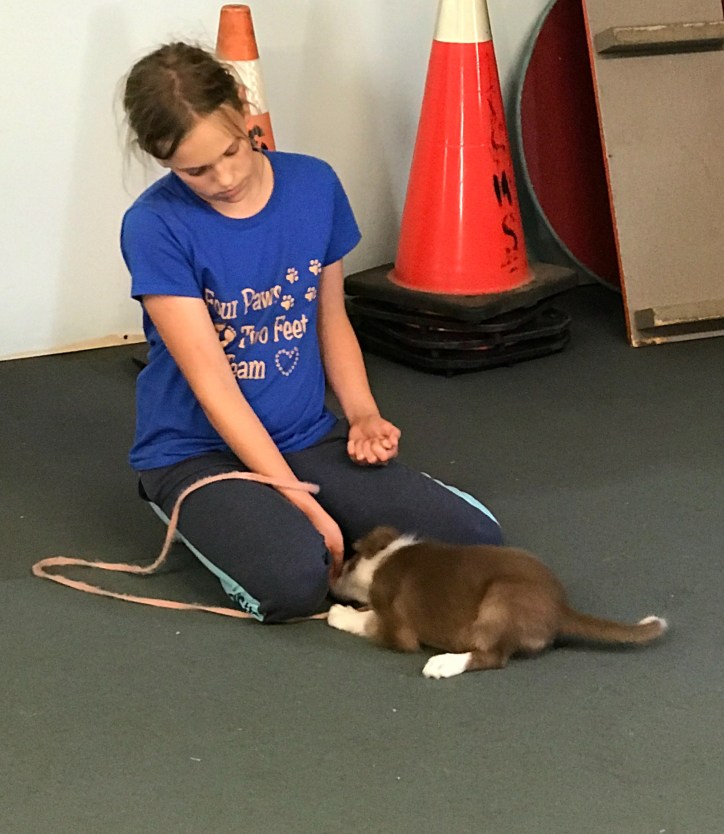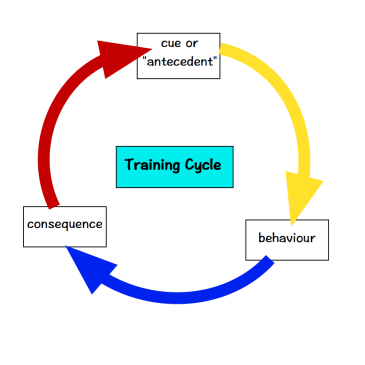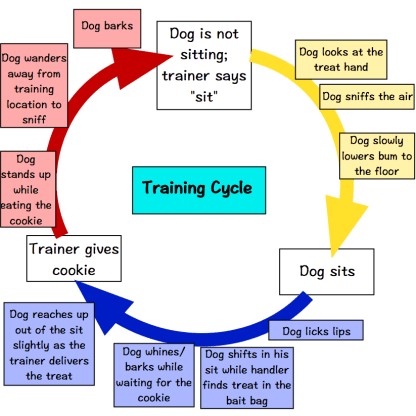
We will begin with a recap of what a training loop means. Loopy training is named after the cycle that happens in animal training. The behaviour loop first starts with a cue, often called an antecedent. Cues or antecedents can be a lot more broad than most people think as they extend far past the word or hand signal we think of as the cue to environmental cues for the dog such as where we are located, how we are standing, or if there are any other prompts present such as a mat or kennel. Even time of day and the clothes we are wearing can all be part of the antecedent. Then comes the “target” behaviour that we are hoping to train. Then the reward sequence is initiated and ends with the animal consuming the reward in some form. If the reward is a cookie, we can see how that would happen, but if the reward is touching, or a play session with a toy, the reward ends when the handler stops delivering the reward. At this point the cycle can start again, hence why it is called a cycle. Let’s take a look at what this can look like…

So for a sit, the cycle or loop might look like…

So far so good, right? Well, here is where things get interesting. The cookie the dog gets rewards everything that happens in the cycle or loop. This includes the bits that are hidden in the arrows as well as the “target” behaviour of sit that we are actually trying to reward. The sloppier our training, the more bits of “garbage” that get accidentally reinforced in our loop. Here are some examples of the sloppy bits that are hidden in the arrows and that can become accidentally tied in to our sit behaviour if we aren’t carefully planning to avoid them.

So how do we avoid this mess? Well there are lots of things we can certainly do along each of the coloured arrow sections to help our dogs be able to focus on learning the target behaviour we want and not the other things in the above loop. Working on tightening up the arrow sections helps us create tight training loops sometimes called Loopy Training. For this article, I’m going to focus on the blue arrow as it is this piece that is often forgotten about and many of us are probably not even aware that the behaviours on this section are part of the loop at all.
So….what can you do as a trainer to help tighten up the blue part of the loop? Here are 5.
- Be a clean trainer. The mechanics of good operant training require that you give your “event marker” BEFORE you initiate the reward sequence. In practical terms this means that you “click” or say “yes” before you begin your reach toward the bait bag or treat bowl. I often see trainers reaching for the bait bag before the event marker is completed. This causes problems for a variety of reasons including building eye shifting and perhaps weight shifting, or even full orientation toward the food location into the behaviour. It also creates the messy question about what the event marker actually is. Is it the “click” or is it the movement of your hand?
- Practice the mechanics of your treat delivery without your dog before you begin. Do this in the place where you will train, imagining the dog is doing the same behaviour you are about to work on.
- Have your treats ready by preparing them in advance into small bite sized pieces for your training session. They should be out of the wrapper and ready to deliver straight into your dog’s mouth.
- Have the treats easily accessible in a bowl or bait pouch so you don’t have to dig into the pockets of your skinny jeans or through several zip lock bags to get out the reward.
- Use a specific reward cue that tells the dog what reward to expect and how to access it. This is a pretty new idea for me, as, although I have a few words that tell my dog to access reinforcers, I usually use the same words for toys and food and I sometimes also use the same word for come and get the reward, and stay there, the reward is coming to you. This leaves the dog to read other contextual cues to know which reward getting behaviour to initiate. I’ll do another, more detailed post on this later, but a simple example would be to say “yes” and deliver the cookie at your side so that your dog comes toward you and takes the cookie from your hand, or say “niiice” and deliver the cookie to your dog’s mouth in the style of a baby bird. Hannah Branigan calls these two delivery styles “take out” and “room service” respectively. Using different cues reduces the risk of confusion and frustration in the blue part of the loop which can sometimes mean a delay in the blue portion of the training loop.
There are of course lots of other ways to clean up the blue arrow part of the loop, but if you try the 5 above, I think you will find they make a big difference. Happy training!
Heather